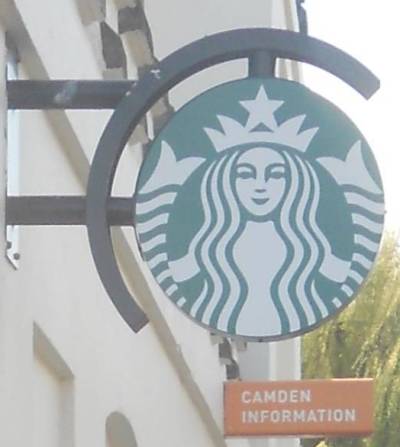Do we really need a Canal Information Centre?
Judging by the lack of interest shown in the existing centre over the past few years, then it is questionable
whether it serves any purpose. Most of the existing information on display relates to the wider area, rather
than the adjoining canal; the information is rarely updated, it is mostly inaccessible; and it transpired that most boaters,
local residents and visitors were unaware that the centre even existed.
One thing that deters visitors from using the centre is that the black door below the orange information
sign is permanently locked, so they naturally assume that the centre is defunct.
Regular boaters have not used it in recent years, because they have always been able to collect information
from the popular Paddington Information Boat, named
Jena.
Sadly, this service was discontinued in December 2011 and the Canal and River Trust has not revealed
any plans yet for replacing Jena or for producing information leaflets to the standards that
we had become accustomed to.
The information centre could serve two categories of visitor. First, the visitors who are drawn to the area
by the canal itself;
they will want to go straight to the information centre, to plan their journey and learn about the local history;
they will not want to be pressurised into buying coffee and they will expect to find a focal point within the building.
Second, there will be customers who will notice the murals and information while buying and drinking their coffee;
a sizeable proportion of these customers will make unplanned use of the information,
and Starbucks will have been instrumental in educating these customers about the canal.
Clearly, it is important that visitors are made aware of the information centre before they arrive in Camden Town.
This will require a combination of signage (along the canal) and publicity (for example in travel guides).
|
|
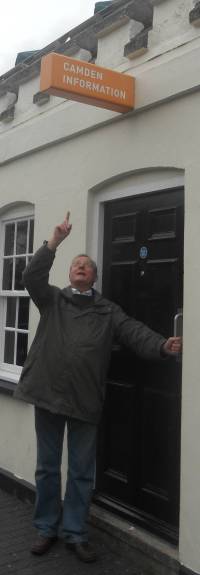
|
Community Uses of this Facility
This facility could also be used for holding canal-related community meetings (for example between volunteers)
and for canal-related workshops for local schools. This could be achieved by reserving a few tables in a
designated part of the building. Typically these events could take place between 10am and 4pm.
|
Where will the Volunteers come from?
Finding and keeping volunteers is not going to be easy. The Canal and River Trust is going to discover this
on a very large scale over the next five years. This is also a threat to the "Big Society" dream, which is relying
heavily on reluctant volunteers to supplement the well established network of natural volunteers.
So we cannot assume that there will be a guaranteed supply of volunteers, and we must manage vistors'
expectations accordingly. At the moment, we need to consider the types of volunteers that will find
it attractive or convenient to work here.
One of the attractions of this centre is that it allows for all-weather volunteering
and the work is not physically demanding. Another attraction (pehaps for the younger generations)
is the trendy location. This is a particularly vibrant part of the canal, as it is the starting point
for a number of journeys in both directions, and we can also expect to see volunteer lock keepers operating in this area.
For weekends and school holidays we should aim to recruit teenagers who are keen to learn about the canal
or gain experience in serving the public. We cannot expect to retain these volunteers for more than a few months,
but it might be possible to rotate them between the information centre and various local museums in order to
broaden their experience.
For weekdays, we should reach out to adult age groups, through a combination of the Inland Waterways Association,
local community groups and London-wide volunteering organisations.
As well as identifying sources of willing volunteers, we need to establish whether or when the centre needs to be staffed.
Will it require volunteers on stand-by at core times?
Or will it suffice for them to drop in at regular intervals to check things over and to respond to messages?
We will also need volunteers to help to prepare, verify and update the canal information.
The attraction of this work is that it can be undertaken off the premises and it will suit people
who cannot commit to a rota of duty.
|
What type of Information is required?
This centre is not intended to be a substitute for the London Canal Museum.
There is simply too little space available for anything substantial.
But as a minimum it will contain historical details about the Lock Keeper's Cottage and the surrounding locks,
wharves and market areas. This will be its main theme, but it will also require maps and information covering
the rest of the Regent's Canal.
Here are some ideas
- History of the Lock Keeper's Cottage
- History of the surrounding area (including the locks, stables, the markets)
- History of the Regent's Canal
- Opportunities for boat trips and guided walks along the Regent's Canal
- Other canal-related sites of interest in the London area (e.g. the London Canal Museum)
- The wider waterways network and what it offers (e.g. Canal Holidays)
|
Fixed or Portable Information?
For reasons of cost, the majority of the printed information will need to remain inside the building.
Some of this will be displayed on the walls; some will be in binders that are not to be removed.
This should be satisfactory for historical information, but visitors will often expect to be able
to pick up free maps and leaflets.
We can reasonably expect Transport for London to publish and distribute maps, to allow walkers
to find their way along the towpath.
It would also be useful to offer booklets and books for sale. One possibility would be to
provide reference copies for visitors to thumb through at the information desk and to direct the visitors
to the coffee counter till to buy copies to take away.
|
Electronic or Hardcopy Information?
We must find a realistic and flexible balance between supplying information in electronic or paper form.
We need to look at this from two angles :-
(a) what it costs to produce the information
(b) what the visitors expect and want
We could keep costs to a minimum by going all electronic and outsourcing the computer maintenance work.
But this would negate the need for a drop-in information centre. It would also force everybody to buy up-to-date gadgets,
which do not work well in sunlight or rain, and can be a magnet for muggers. A lot of people visit to canal as an escape
from the stress of modern life, so electronic media will not suit everybody.
At the other extreme, we could be very old-fashioned and boycott electronic information.
But this would exclude a huge proportion of the visitors and volunteers that we are trying to attract
and it will push costs up.
So we need to find a balance, where visitors can choose the media that they are comfortable with.
There is no reason why we cannot ask volunteers to help to maintain websites and published information,
but we must look to other sources for funding the printing of the information
and the running costs of any computer monitors.
|
What Scope and Depth of Information is required?
We could consult tourist information experts to find out what tourists expect,
just in case they receive frequently asked questions or complaints that we could address.
We also need to be proactive and to produce information that we think is useful, accurate and interesting.
The onus is now on the community to decide what information we would like to put on display.
If you have any suggestions then please send an e-mail to
friendsregentscanal@gmail.com
|
What is wrong with the existing Facility?
The only entrance to the information centre is via the Starbucks doorway, which can be very congested at times.
There is no "CANAL INFORMATION CENTRE" sign at the doorway, so most canal-specific visitors are deterred from entering.
They would naturally assume that the centre had been relocated or closed down forever.
|
|
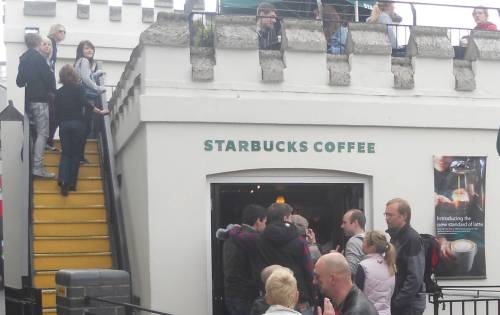
|
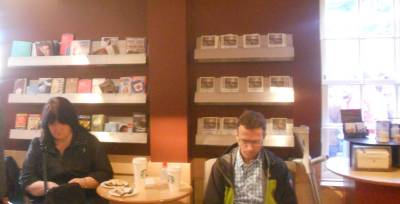
|
|
There is no longer any focal point for information inside the building. The closest approximation is the leaflet racks
to the left of the self-service area for milk and sugar.
Most of the leaflets are unrelated to the canal.
For example, leaflets for the Brighton Festival.
|
The wall displays are out of reach to most customers due to furniture clutter.
They have become more of a distraction than a feature. One of the windows is completely covered
by the display boards, so the visitors lose out on a view of the canal as well as losing natural light.
Only a small proportion of the information is canal-related.
There are two monitors attached to one of the walls. They are not connected to the internet;
they merely display information that is similar to the wall displays.
This information does not appear to have been updated since the turn of the century.
|
|
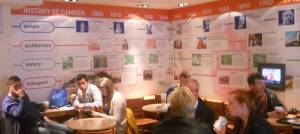
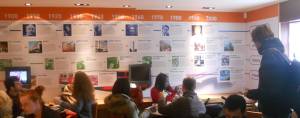
|
|
Here is a rough sketch of the existing layout.
|
|
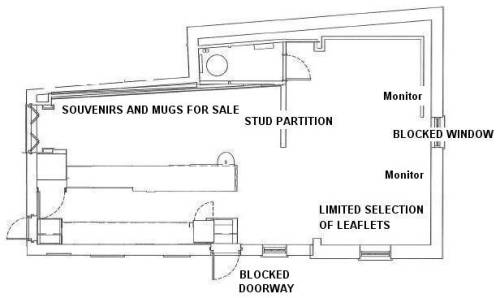
|
What are our Options for changing the Layout
Hopefully the visitors and coffee customers will be able to co-exist in this shared space, provided that certain
changes are made.
A clear sign is needed at the main entrance, to show that this is a public space as well as a commercial coffee shop.
Currently the only visible sign is "STARBUCKS COFFEE". This could change to "The Lock Keeper's Cottage"
and there should be two separate signs saying "STARBUCKS COFFEE" and "CANAL INFORMATION CENTRE".
These signs should be equally sized, but in different fonts and colours, to emphasise that the building
serves two separate functions. It is important that people recognise that Starbucks wants to support the
information centre but does not own or control it.
The area inside the entrance is very cluttered, with merchandise for sale and some sofas.
If this area is decluttered then visitors will be able to walk to the information area without being
caught up in the coffee queue and the information area could be in their direct line of sight
when they are at the doorway.
|
Here are two possible layouts that we could consider.

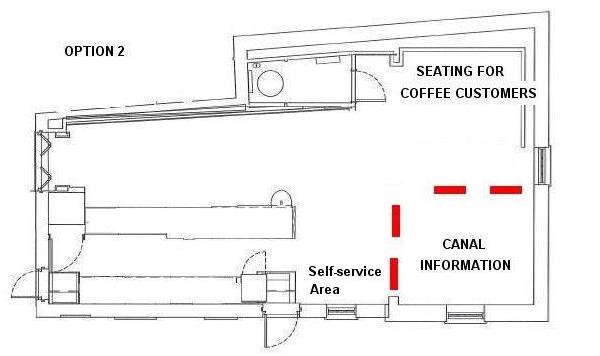
In both these examples, the red dashed line indicates a flexible boundary
between the information focal point and the coffee customer's main seating area.
This boundary would vary throughout the day.
Option 1 appears to be more practical for the canal visitors,
because it allows them to walk directly to the "information desk" without
competing for space with customers at the self-service area.
Where exactly is the Lock Keeper's Cottage?
The building can be reached from Camden High Street. Its approximate location is indicated by
the red rectangle below.
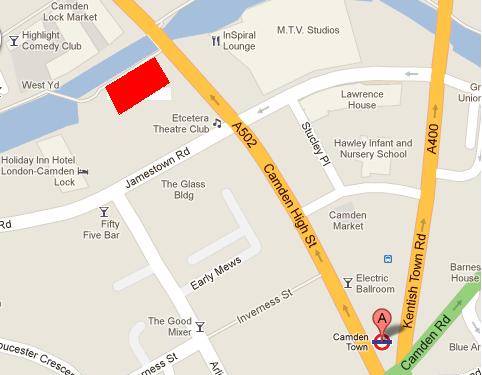
|
Who will pay for the Installation and Maintenance of the Equipment and Information?
In the first instance we can expect Starbucks to contribute to the funding of any equipment.
This is simply a continuation of the tenant's existing responsibilities under a Section 106 agreement.
Depending on the type of information we are going to display, we can also expect assistance from Transport for London,
the Canal and River Trust, Camden Council and local businesses.
Our first priority, however, is to reach agreement on the type of information we need.
|
Can you help?
If you have any questions on this subject, or suggestions,
or if you would like to help to produce, review, update or distribute
any information (electronic or hardcopy) then please send an e-mail to
friendsregentscanal@gmail.com
|
|
